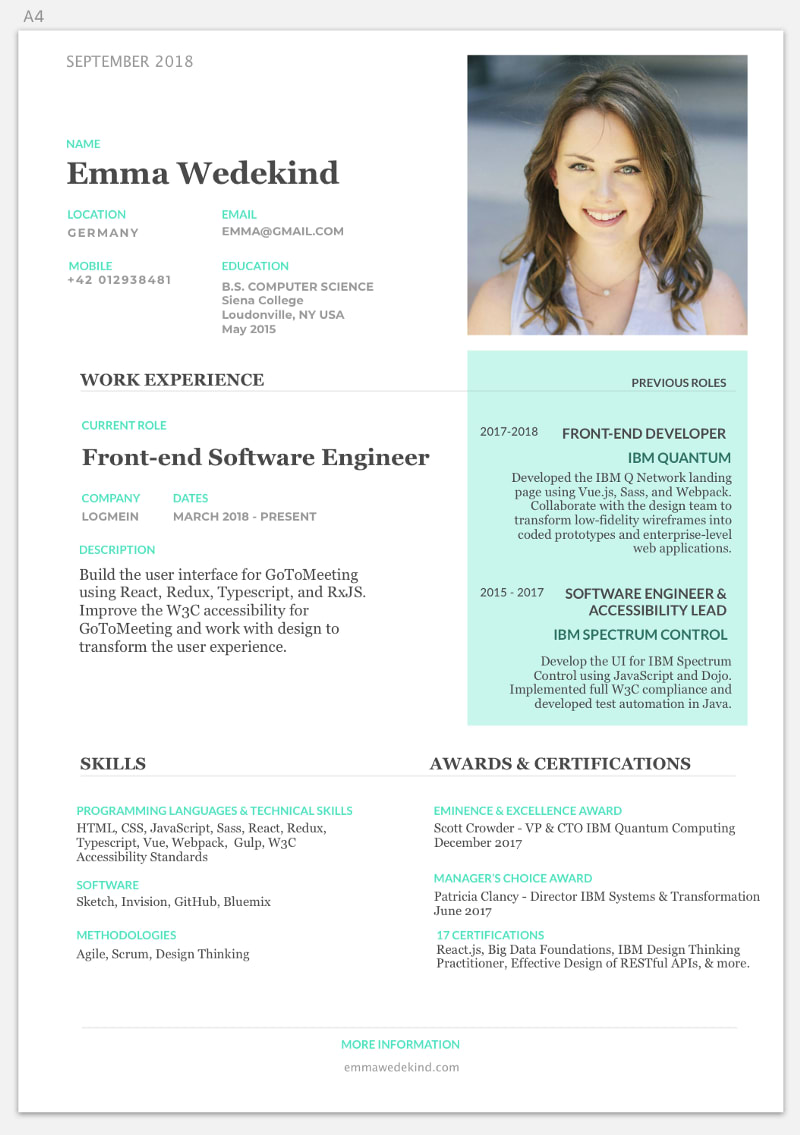Writing a resume is hard. Yet even today, most job applications require resumes to be considered for a position. The true goal behind a resume is to market yourself. You are your best advocate.
You must create a resume that can advocate for you even when compared with many other qualified candidates.
Education
If you are a college graduate, it’s not necessary to list your high school experience.
If you have attended a boot camp but do not possess a college degree, you can include your high school information.
If you have studied abroad, you’re welcome to add this information beneath your main degree program (if space permits).
Any college degree should be listed in reverse chronological order (Ph.D, M.S., B.S.).
College Or High School Graduate
- Name of the institution
- City/state/country
- Month and year the degree was obtained (or expected graduation date)
- Degree information (i.e. B.S. Computer Science)
Boot Camp Program
- Name of the program
- City/state/country/online
- Month and year the program started
- Month and year the program ended (or expected completion date)
- Program information (i.e. Front-end Development Program)
Contact Details
You can add contact details to the footer of your resume, but they must be present in the body of the document as well.
You may also choose to include links to social media or networking sites such as LinkedIn, GitHub, CodePen, and more.
Just ensure they’re done in an appropriate manner and don’t take away from the main content. Steer away from including sites that do not have a lot of information or substance to them.
- Full name
- Current city/state/country
- Phone number
- Email address
- Personal portfolio/blog/social media/GitHub, etc. (where applicable and relevant)
Work Experience
This is one of the most vital sections on a resume. If you’re just graduating high school or college and have no relevant work experience, you can include one to two jobs which indicate your employment history.
It’s best to list work experience which exemplifies the industry you wish to be part of. Internships are a great way to get some work experience and I highly recommend this for people who are new to the industry.
If you don’t have the means or ability to obtain relevant work experience, include projects you have worked on which showcase your skillset. Freelance work is also a great way to get some experience.
- Employer name
- City/state/country
- Month and year employment started
- Month and year employment ended (present or current if you still work here)
- Job title
- 1–2 sentences, or bullet points, stating what you were responsible for. These should be specific examples of contributions you made. Stay away from generic filler text. Use positive language such as achieved, influenced, mentored, and launched.
Skills
The skills section is the second most important section on a resume. Its primary concern is listing all of your technical and non-technical capabilities.
Personally, I believe you should leave off skills similar to“Microsoft Word”, “Keynote”, and “Mac OS”. These skills are quite standard and can make it appear as though you’re trying to fill space on your resume.
Instead, showcase the skills you’re proud of and which differentiate you from the competition.
Do not list skills which you would not be comfortable answering questions about on a technical interview.
I have made this mistake myself, but potential employers are free to ask you questions regarding any skill listed on your resume.
If you created a small pet project using PHP back in 2011, but forgot all the necessary skills, don’t list it.
I like to break my skillsets down into buckets:
- Programming Languages & Frameworks (JavaScript, React, etc.)
- Software (Sketch, Adobe Illustrator, etc.)
- Methodologies & Practices (Agile, Scrum, etc.)
Personal Statement & References
I personally find a personal statement to be outdated. In prior years it was standard to include an objective, but the standards for resumes have relaxed a bit in recent years. You are welcome to add a personal note or objective, but I don’t find it necessary.
I tend to leave references off of my resume. If a potential employer requires references, they will ask you. Thus, I save the space and leave them off.
Additional Information
Awards and certifications are great things to add (if you have the space). If you have a lot of these, narrow them down to the top five which best represent your work or character.
Additionally, adding some of your personality into your resume can go a long way to differentiating you from the crowd. We’re spoiled by the informal nature of the tech industry, so our resumes can leverage a bit more creative license.
By incorporating small colloquialisms and designs into our resume, you show the hiring manager or recruiter who you are.
It’s important to put love and effort into your resume as this can indicate to the employer your attention to detail.
Keep It Succinct
Unless you have ten or more years in the relevant industry, your resume should be no longer than one page. Often, recruiters will glance at the first page of your resume and throw it aside if they don’t immediately see something worth a deeper look.
You have once chance to make a good and unique first impression.
Be Selective About Technology Skills
Do not list every single skill or technology you’ve ever acquired. If you don’t currently possess it, don’t list it. It could lead to some awkward conversations in an interview.
Don’t Include Every Detail About Your Life
You have at most two pages to convince an employer they should at the very least interview you. Thus, it’s important to be selective about what bits of information you share.
Additionally, you want to leave room for some intrigue. If you list everything about yourself on your resume, there’s nothing left for the employer to ask you about.
Format Is Key
There is nothing worse than a resume with spelling and grammatical errors.
To combat this have two or three people review your resume. Ask them what their first impression is at first glance. Many programs include spell check; use it.
Be selective and consistent with your font choices and ratios. Do not choose “fun” or difficult to read font. Stick with a serif or sans-serif font. Use at most two font families.
Your font should be no smaller than ten pixels.
Ensure you are consistent with spacing. This can have a major impact on the clarity and visual attractiveness of your resume.
There are many programs you can use to create your resume. Most applications require a .doc, .docx, or .pdf format, so ensure the program you select can export to these file types.
I highly recommend first creating a bare-bones resume with the content as the main focus. “Pretty” resumes are wonderful, but are only effective if the content stacks up.
Software For Creating A Resume
- Microsoft Office
- Google Doc
- Resume Builders
- CV Compiler
- Sketch
Phase 1: Bare Basics
Here is what an example “basic” resume might look like. I created this using a Microsoft Word template.
This is a great first step towards creating an awesome resume. The focus of this version should be the content.
You may choose to use this as your final product, and that’s fine. But adding a few visual enhancements will greatly improve your ability to stand out.
Phase 2: Visual Flair
Now it’s time to add some visual flair. I prefer to use Sketch to create beautiful graphics and designs. You can download a free version and find some awesome YouTube tutorials to get started.
You can also create custom resumes using Google Docs or Microsoft Office, but it might take a bit longer.
I tend to stick to one or two colors. Nothing too bright or abrasive.
It’s not a necessity to include a photo. I tend to select a photo which matches my social media accounts and LinkedIn so I am easily identifiable.
By creating a beautiful resume, you’re likely to stand out from the crowd.
Both of the resumes can be downloaded below. Feel free to customize them to your liking!
By leveraging these tips, you’re bound to create a stand-out technical resume. It’s important to always keep your resume relevant as your skills, work experience, and education changes.
I highly recommend using a service like CV Compiler to check the validity of your resume once it’s written. This is by-far the best resume analyzer I’ve used to date.
Good luck and feel free to reach out on Twitter if you have any questions!














Top comments (24)
The resume with the picture is very clean and visually different. However, I feel like it could introduce bias (although no one will admit it, of course) by including it. One of those conflicts between really caring about quality and the clash with the corporate world.
First impressions are important. They will likely see them when they come in for the real interview which makes the bias still possible. I had a mentor that got refused because he didn’t fit their image for the role.
I don't understand why you put picture of yourself on a resume. I believe that recruiters should look on your skills and education and maybe application letter but not on how you look like as that has nothing to do with the job you are applying for.
I really like UK standards where actually CV with photo will likely be discarded.
I agree with your point but there are job applications where it is required to have a photo, in Switzerland at least.
Personally, I would opt for a smaller photo in passport format.
You don't need to add a photo. It's personal preference.
Hi! I've just joined this site and your post happened to be one of the first I stumbled across.
Having checked out your other posts it's interesting how closely they resemble the sort of content I was planning on releasing on my personal site - I'm sure I'll use some of your writing skills as inspiration!
Keep up the great posts - thanks for sharing.
Thanks Emma for the post on resume writing! I didn’t really think about the current tech stack rule regarding resumes, and now I think I’m going to consider that when rewriting my resume.
One question I have is this: You talked a lot about the advantages of a visual resume and I like how they look, but my concern is don’t they get passed in resume screening software?
They definitely do get past ;)
Great article,
I think having a colorful and well designed CV is a big plus point for a front end/UI developer.
Back end guys can live with a plain bare minimum - as long as it's well structured and succinct.
Nice resume and article about it.
I like the general look of both resumes but I have a second look, they don't tell me a lot.
Assuming that recruiters will have a first look who don't have a lot of time and sometimes knowledge about our industry, I think you'd do better for yourself to share some numbers. Like "reduced load time by 30%", or "designed a UI for collaborative space with +500k visitors a month". Something that actually impresses people.
Regarding your skills. Are you proficient in all those? Or you also list what you are familiar with? Do you think it's worth to group and share your level of expertise (even if it is still vague)?
I think you still have plenty of space to show recruiters even more how great you are.
I only list technologies I'm comfortable being interviewed on or have worked on in a professional setting(typically)
Do you think it's a good idea to highlight what someone has done on social media, like your success with dev.to for example (possibly including some stats)? Or would doing that look bad on a resume?
Like Emma said, be selective and add the important stuff that showcase your talent. I would say if it demonstrates what you do, yes. If you're a writer, your blogs demonstrate your style and ability to communicate. If you're a developer, your GitHub repos show your coding style and ability to make stuff. If you're in marketing, social media show how you convey a message and increase engagement.
I will add that I've stopped putting my graduation dates on my resume. I still put 'Degree obtained: BS in Computer Science' but I quit putting year that i graduated was 2000. Similarly, I limit my list of employers to about whatever the job requests for the position. If the job requires 5 years experience, then I will put up to 5 years experience.
Reason being, is that I find that I don't get initially rejected due, and I seem to get farther along in the interview process. I seem to get to alot more of the 'phone screen' or 'in person' portions of the interview.
Great article, but please never add photo to your resume. It's a no-no practice. I would also recommend to check the fullstackresume.com service to build your Full Stack Resume in less than 30 seconds. Instead of writing all the content by yourself the service will generate it for you based on your unique experience using minimalistic A/B tested template!
Didn't know about CV Compiler. Great advises.
I'm literally writing my first technical resume right now! I stopped to procrastinate, and this new article pops up. Thank you!
Nice article. What is your CV compiler score mine is 56%.
Hi Emma,
A pretty nice post!
Based on yours, I have written mine :)
dev.to/jolo/how-i-used-css-grid-fo...
Cheers and Greetings from upper Germany ;)
Lovely
thanks for sharing your tips Emma. It looks clean and informative with your CV.
Some comments may only be visible to logged-in visitors. Sign in to view all comments.